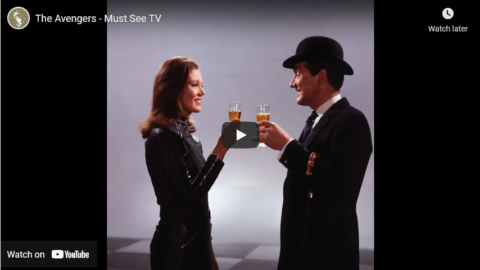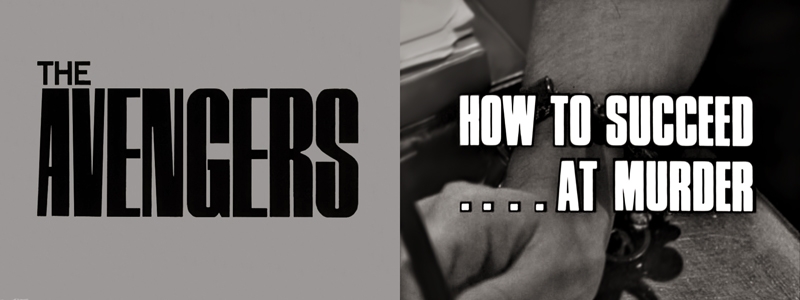Billy Rees
Published 19 Aug 2015ITV programme from 2005 presented by Joan Collins.
June 1, 2021
The Avengers – Must See TV
February 22, 2018
The worst episode of The Avengers? “How to Succeed … at Murder”
In a column ostensibly devoted to the British Labour party’s ongoing ructions over their “all women shortlist” problems, David Cole recaps what he calls the worst episode of the brilliant 1960s British TV show The Avengers:
When I think of The Avengers, what comes to mind is not the bloated comic-book franchise in which overpaid actors cavort in front of a greenscreen for the masturbatory pleasure of nerds. No, to me, there is and will always be only one Avengers, and that’s the 1960s British crime and espionage TV series. As a kid, it was my favorite show, and I have fond memories of rushing home from elementary school every day to catch Emma Peel (my favorite of John Steed’s female partners) in action.
Among Avengers superfans, there is one episode that is generally considered the worst. Indeed, the episode is outright despised, because in a series lauded (and properly so) for being a trailblazer when it came to presenting strong, intelligent, and independent action heroines, the episode “How to Succeed…at Murder” is seen as a giant chauvinistic step backward. It’s known as the “anti-feminist” episode, the one that took the show’s message of female empowerment and stood it on its head. “How to Succeed…at Murder” was first broadcast in March 1966. The setup is typical Avengers-style mystery. Prominent businessmen are being murdered by unknown assailants, and it’s up to Steed and Peel to get to the bottom of it. It turns out, a group of sexy female ballet students have created a secret society dedicated to the destruction of powerful men. They use their feminine charms to get hired as secretaries, only to quickly begin taking control of the business to the point that when they murder the boss, ownership falls to them. The society’s motto is “Ruination to all men.”
Mrs. Peel infiltrates the group and learns that the girls take their orders from a female marionette, which seems to speak and move on its own. In a voice somewhat resembling that of a drag queen, the marionette explains the group’s mission: “To take woman out of the secretary’s chair and put her behind the executive desk. To bring men to heel and put women at the pinnacle of power.”
The marionette’s “helper” is Henry, the clumsy, doughy owner of the ballet school where the secret society meets.
Emma is soon exposed as an infiltrator, and it’s up to Steed to confront the evil ballerinas on their home turf. “No man will dominate us again,” the girls crow as they hold Steed at gunpoint. However, the unflappable Steed quickly deduces that the marionette is actually being controlled remotely by…Henry. Yep, these women had a male boss all along! Revealed as the mastermind, Henry tearfully explains that following the loss of his late wife’s ballet company at the hands of greedy investors, he vowed vengeance against powerful businessmen (it’s also revealed that the marionette is crafted in his wife’s image, and Henry, his mind bent by grief, actually believes he’s his dead wife when he gives the puppet voice). To achieve his revenge against the business world, Henry took advantage of the anti-male sentiments of his students. “No man will ever dominate you?” Steed mockingly asks the girls. “You’ve been taking orders from a man all this time!” As the murderous dancers stand crestfallen, their mouths agape, their boastfulness sapped, Emma disarms the lead girl and beats the living crap out of each and every one of them.
You cannot read a review of this episode on any Avengers fansite without encountering the words “sexist,” “reactionary,” or “misogynistic.” The vitriol stems from the fact that the man-hating feminists turn out to be gullible morons. In their fanatical crusade against male domination, they inadvertently allowed a weak, delusional man-who-believes-he’s-a-woman to dominate and control them.
June 23, 2017
Patrick MacNee of The Avengers on alcoholism and his life
Published on Apr 30, 2017
Patrick talks about his mother began to identify as a lesbian. His father moved to India, and his mother began to live with her wealthy partner, Evelyn Spottswood, whose money came from the Dewar’s whisky business. He called her Uncle Evelyn and he despised her.
He talks about his battle with Alcohol, being a Grandfather, working with Diana Rigg and his book Blind In One Ear. He has a delicious sense of humor and such a fun interview.
He was best known for his role as the secret agent John Steed in the British television series The Avengers. Patrick died in June of 2015 at age 93.
May 19, 2017
Diana Rigg on Farts, Knickers, Breast Size and Stage Nudity
Published on 6 Nov 2015
Portions of a fun interview with Mr. Cavett (America’s best interviewer) from years gone by.
May 18, 2017
The Avengers On Location (1966)
Published on 13 Apr 2014
Beaulieu, Hampshire.
At Lord Montagu’s Motor Museum we see the filming of the ‘tag’ pieces for episodes of The Avengers television series, where Diana Rigg and Patrick Macnee drive off in a vintage car – a different one each time.
Several shots of the cast and crew in the grounds of Beaulieu; Patrick Macnee chats to Lord Montagu. Patrick and Diana get into a veteran car; Diana puts on a groovy kind of face/eye shield and they drive off; they stop and the director gives instructions to Diana; as they start off again funny business ensues as Diana puts her feet up, then jumps from the car, leaps back in, clutches her head and so on.
Diana, in an evening outfit of a chiffon over harem pants, has her make-up touched up. Another sequence is shot with a different vintage car; when it doesn’t start, Diana gets from the back seat into the front and prepares to drive while Patrick goes to the rear to push, and ends up with a blackened face from the exhaust. He gets in; Diana drives off.
Commentator says the crew are trying to complete all these end sequences in one day’s shooting. Diana, in a blue cat suit, chews gum while receiving direction. In this sequence, Diana and Patrick start to push the veteran car which zooms off without them as they chase after it.
Note: according to a press release on file, this series was the first in Colour. More details in notes on the clothes worn and the filming of these tag pieces; Diana’s costumes were designed by Alan Hughes; Patrick wore his own suits!
May 3, 2017
QotD: “Patrick Macnee was a Serious Feminist”
Patrick Macnee
- Refused to model Steed after James Bond because Bond “uses women like battering rams”
- Embraced the concept of a female partner after being cast opposite a male one for a season
- Listened when Honor Blackman began telling him about gender inequality
- Didn’t think that being saved by a woman in any way injured his character’s masculinity
- Consistently gave the women credit for the success of the show
- Recognized that the male producers were chauvinists, and blamed himself for not doing more about it
- Stood up for Linda Thorson when the producers tried to bully her (and was apparently terrifyingly angry about it)
- Was literally the only person on that show that Diana Rigg never said a bad word about
- Consistently talked about being raised by women and viewing women as equal to men
Lauren H. Brooks, “Patrick Macnee was a Serious Feminist”, Kinkiness … and Patrick Mcnee, 2017-04-21.
July 1, 2015
Remembering Patrick Macnee … I mean, of course, John Steed
Mark Steyn on the (not-technically) original Avengers star:
But for a while Americans liked The Avengers, and it lingered in the memory so warmly that, three decades later, Hollywood opted to do a big-screen, big-budget remake. Patrick Macnee, the original John Steed, sportingly agreed to do the usual cameo — in this case, as a ministry bureaucrat rendered invisible in some research mishap and now consigned to a cramped office in a Whitehall basement. As I say, he was invisible, so we heard Macnee’s affable drawl (he had a smile in his voice, even when beating up the bad guys), but the audience never saw him, which was probably just as well — because, if they did, they’d remember the sheer affability of Macnee’s Steed. He was never a conventionally handsome leading man — he had a bit of a dumplingy face — but he brought a bonhomous ease to the role of the unflappable secret agent: the bowler, the brollies, the buttonholes and the Bollinger seemed like natural extensions of his charm; you can understand why groovy birds like Honor Blackman, Diana Rigg and Linda Thorson would dig such an ostensibly squaresville cat.
He wasn’t supposed to be the star. The Avengers began in 1961 with Ian Hendry as a mystery-solving doctor David Keel. Macnee returned to England from an indifferent theatrical career in Canada to play the role of Dr Keel’s assistant “John Steed”. But then the star departed, and Steed found himself carrying the show with a succession of glamorous gal sidekicks — Honor Blackman as Cathy Gale, Diana Rigg as Emma Peel, Linda Thorson as Tara King. They were very literal sidekicks in that they kicked to the side, being masters — or mistresses — of martial arts, doing most of the heavy lifting while Steed occasionally boinked someone over the head with his bowler. Many years ago, Dame Diana told me “Emma Peel” came from “M Appeal”, as in “Man Appeal”. But Steed always called her “Mrs Peel”, just as he called her predecessor “Mrs Gale”, because he was a gentleman. And the ladies always called him “Steed” because they were one of the boys, as in that English public-school thing whereby grown-up chaps who know each other well address each other by their surnames (“I say, Holmes!” “Yes, Watson…”).
The Avengers was created by Sydney Newman, the greatest of all Canadian TV producers (he also inaugurated Dr Who), but hit its high-water mark under Brian Clemens and Albert Fennell. In the early days, they didn’t have a lot of money, but they spent it wisely. The difference between the two principals was defined in what they wore and what they drove: Steed favored a vintage Rolls or Bentley, the ladies the latest convertible sports car. After seeing Mrs Peel drive one, my dad bought a Lotus Elan — a beautiful ride with a fiberglass body that crumpled to dust when a truck brushed us ever so lightly on the Route National 7 in France. The ladies wore fab gear from Carnaby Street, while Macnee, ditching the trenchcoats he’d worn in the first series, opted for a slightly heightened version of an English gent’s get-up that he designed with help from Pierre Cardin. Laurie Johnson wrote one of the best telly-spy theme-tunes and the opening titles are pure style: Mrs Peel shooting the cork off the champagne bottle, Steed’s unsheathed sword-stick swiping a carnation and sending it flying through the air for Mrs Peel to put in his buttonhole.





